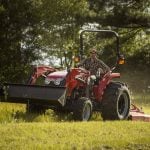Chief executive officer of DOT Autonomous Farm Technology says the pressure on food exporting countries is enormous
“If you want to know who I am, this is who I am,” says Robert Saik, as he points to a screen displaying the chromosomal complex that makes up his genome.
“If you want to go deeper we can go into the genes inside of my genome sequence and know if I’m susceptible to any diseases too.”
Saik, chief executive officer of DOT Autonomous Farm Technology, opened his presentation at the Pacific NorthWest Economic Region summit by comparing the amazing advances in genetic technology with the often-negative view of genetically modified organisms.
Read Also

Farming Smarter receives financial boost from Alberta government for potato research
Farming Smarter near Lethbridge got a boost to its research equipment, thanks to the Alberta government’s increase in funding for research associations.
“People are fascinated by this but when you talk to them about the very science that is on the screen as it pertains to agriculture, they vilify it. Explain that to me. Riddle me that,” he says.
The main focus of Saik’s presentation wasn’t GMOs but rather trends in world population and agriculture and how technology fits into that discussion. One example he gave was how the world population is projected to continue increasing, even as crop production trends the other way, with places like Germany seeing their smallest rapeseed crops since 1998.
“The real kicker is, we have to grow 10,000 years’ worth of food in the next 30 years. Every region on the planet has to grow 60 to 70 percent more food to meet the 2050 population. We don’t think about that enough. The pressure that puts on exporting nations like the United States and Canada is extraordinary,” says Saik. “We’re on a precipice. We’re like lemmings running to the ocean where science isn’t guiding anything anymore. It’s opinions and feelings that are guiding it.”
When Saik talks about the history of agriculture, he references five iterations: the era of muscle, the era of machine, the era of chemistry, the era of biotechnology and genetic engineering and the era of convergence. He says we are in the era of convergence right now, which is the “bringing together of technology in lightning fast speeds.”
“DOT is a technology that is a 100 percent autonomous robotic technology. It’s an example of what I’m talking about, convergence,” says Saik.
“DOT has huge processing on it. DOT has GPS, GIS guidance. It’s got LIDAR, radar, and photometrics all converging into this autonomous seed drill. It’s a 100 percent robotic platform; there is no cab.”
Saik says the agriculture industry is facing problems such as climate change, seed regulations, farmers needing more insurance options and oil being moved on trains at the expense of grain. However, the one problem that could hinder the technological advances that are happening right now is connectivity, he adds.
Saik showed data from a study that asked farmers how satisfied they were with their farm’s cell coverage and internet. Over 50 percent of farmers were unsatisfied to some degree with both of them.
“Imagine running a ten million dollar business in Vancouver without the internet,” says Saik. “It’s ridiculous and that’s what our farmers are being told. A majority of our farmers are struggling with connectivity. You cannot run a smart farm with a stupid connection.
“In summary, we need to figure out new ways for farmers to have access to private insured schemes, fight hard for transportation —grain can’t move by pipeline. We need to support increased public awareness, especially science, and we need to enhance agricultural automation on the farm, connect the farm.”

















